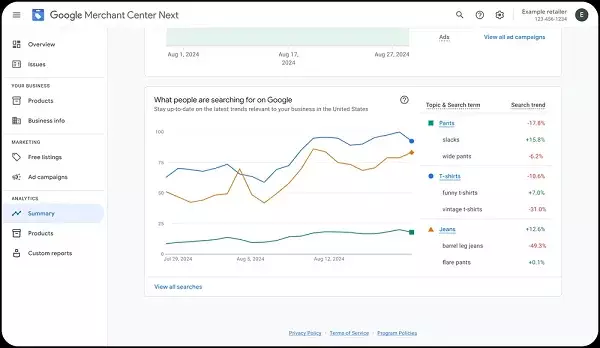As the holiday season approaches, Google is rolling out new updates to help businesses optimize their Google Shopping listings through the Google Merchant Center. One of the key updates includes the addition of product trend insights. These insights will provide businesses with valuable information on key shopping search and purchase trends, allowing them to stay ahead of the curve when planning their marketing campaigns. This feature has the potential to be a game-changer for businesses looking to capitalize on trending products and improve their inventory decisions. However, there is a concern that relying too heavily on trends may lead to a lack of long-term strategy and sustainability in marketing efforts.
In addition to product trend insights, Google is introducing more artificial intelligence elements to its Merchant Center analytics. One of the new features includes summaries of recent product performance, giving businesses a glimpse into which products are gaining traction and key trends that can help prioritize marketing efforts. While AI-powered analytics can provide valuable insights, there is a risk of oversimplification and potential inaccuracies in the data interpretation. Businesses must strike a balance between leveraging AI tools for efficiency and ensuring the accuracy and reliability of the data.
Conversational Queries in Reporting
Google is also integrating conversational queries into Merchant Center reporting, allowing users to request custom data sets based on specific performance metrics. This AI-powered tool aims to simplify the reporting process by generating personalized reports tailored to the user’s needs. While this feature streamlines data analysis, there is a concern about the potential lack of transparency in the data generation process. Users may overlook errors or discrepancies in the data set due to the automated nature of the reporting, raising questions about data integrity and reliability.
Another update from Google includes an automated onboarding process for product availability notes on listings. This feature syncs in-store availability information from the business website and integrates it into the Merchant Center account. While automation can streamline processes and improve efficiency, there is a need for caution in relying solely on automated systems for critical tasks. Businesses must ensure the accuracy and relevance of the synced data to avoid potential discrepancies in product availability information.
Google is also introducing new customer acquisition goals in Performance Max and Search campaigns to help businesses refine their targets and optimize their Google campaigns. These updates aim to enhance the performance of Google Shopping listings and drive more conversions. While setting clear customer acquisition goals is essential for campaign success, businesses must continuously monitor and adjust these goals based on real-time data and performance metrics to ensure optimal results.
While Google’s new updates for holiday marketing offer promising features and improvements for businesses using the Google Merchant Center, there are critical considerations to keep in mind. Leveraging AI-powered analytics, trend insights, and automated processes can enhance marketing efficiency and performance, but businesses must maintain a balance between automation and human oversight to ensure data accuracy and reliability. By carefully navigating these updates and utilizing the available tools effectively, businesses can maximize their marketing potential and drive success in the competitive holiday season.


Leave a Reply
You must be logged in to post a comment.